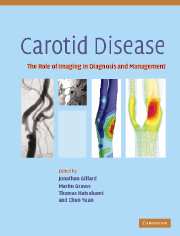Book contents
- Frontmatter
- Contents
- List of contributors
- List of abbreviations
- Introduction
- Background
- Luminal imaging techniques
- Morphological plaque imaging
- Functional plaque imaging
- 19 Nuclear imaging for the assessment of patients with carotid artery atherosclerosis
- 20 USPIO – enhanced magnetic resonance imaging of carotid atheroma
- 21 Gadolinium-enhanced plaque imaging
- 22 Carotid magnetic resonance direct thrombus imaging
- Plaque modelling
- Monitoring the local and distal effects of carotid interventions
- Monitoring pharmaceutical interventions
- Future directions in carotid plaque imaging
- Index
- References
19 - Nuclear imaging for the assessment of patients with carotid artery atherosclerosis
from Functional plaque imaging
Published online by Cambridge University Press: 03 December 2009
- Frontmatter
- Contents
- List of contributors
- List of abbreviations
- Introduction
- Background
- Luminal imaging techniques
- Morphological plaque imaging
- Functional plaque imaging
- 19 Nuclear imaging for the assessment of patients with carotid artery atherosclerosis
- 20 USPIO – enhanced magnetic resonance imaging of carotid atheroma
- 21 Gadolinium-enhanced plaque imaging
- 22 Carotid magnetic resonance direct thrombus imaging
- Plaque modelling
- Monitoring the local and distal effects of carotid interventions
- Monitoring pharmaceutical interventions
- Future directions in carotid plaque imaging
- Index
- References
Summary
Introduction
Atherosclerosis affecting the carotid arteries is an important cause of thromboembolic stroke and thus, its identification in patients at risk of stroke is desirable. Over the past three decades many attempts have been made to utilize nuclear imaging technology to identify atherosclerotic lesions in the carotid arteries. Early studies focused on providing the clinician with noninvasive alternatives for angiography such as ultrasound, computerized tomography (CT) and magnetic resonance (MR). The ability to identify lesions in large vessels such as the carotid artery, meant that developing nuclear imaging techniques as a means of simply confirming the presence of atherosclerosis was no longer justified. However, interest in developing novel nuclear imaging techniques has resurfaced following the realization that, much like coronary disease and myocardial infarction, thromboembolic stroke caused by carotid atheroma occurs as a result of plaque rupture. It is now widely accepted that the risk of plaque rupture is dictated by particular pathological processes at the cellular and molecular level, the identification of which nuclear imaging is ideally suited.
This chapter begins by outlining the basic principles that underpin nuclear imaging. This is followed by an overview of the cellular and molecular pathways that predispose to plaque inflammation, rupture, and thrombosis. The chapter then concentrates on methods for targeting these pathways by way of nuclear imaging. As well as detailing the relevant human studies, this section also outlines the most promising techniques that have so far only been tested in experimental models.
- Type
- Chapter
- Information
- Carotid DiseaseThe Role of Imaging in Diagnosis and Management, pp. 251 - 271Publisher: Cambridge University PressPrint publication year: 2006



